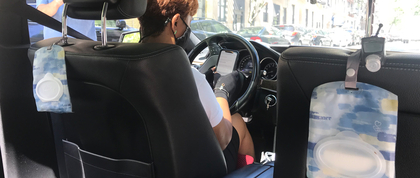
Over the past couple of decades, I’ve trained New York state and city emergency workers who are first responders, whether to man-made disasters such as the World Trade Center attacks or natural disasters like Hurricane Sandy.
More recently, my work was with hospital first receivers, helping them triage incoming patients, minimize contamination, and differentiate between the "worried well" and the "walking wounded."
But with the outbreak this year of the novel coronavirus, my work in designing teaching modules and conducting training sessions has taken an entirely different direction.
I’ve embarked on a new project with the Independent Drivers Guild, which represents over 80,000 rideshare drivers from Uber, Lyft, and Via in the New York City region. These for-hire drivers must protect themselves and their customers from exposure to COVID-19, while making a living picking up passengers from all walks of life.
Joining me in this work is my long-time mentor and project PI Dr. Jack Caravanos, along with my GPH colleagues Dr. Andrew Goodman, who is our medical expert, and Lucia Girande, an MPH student and our communications specialist.
We’re very enthusiastic about this project and hope it will be a cornerstone for safer practices in rideshare service not only in NYC, but also be adaptable to other cities and states.
The training is a hybrid of interactive videos, PowerPoint presentations and Zoom sessions. Our content covers the basic science of COVID-19; the importance of mutual face covering and mask use; the benefits and differences between hand washing and hand sanitizing; vehicle cleaning and disinfection; the dynamics of air ventilation, re-circulated versus fresh air settings, and opening windows; reducing exposure such as the number and location of passengers and luggage handling tips; and creating a checklist for drivers to follow throughout their daily shift.
The main challenge is getting drivers to effectively "market safety" to the customer, both verbally and through conspicuously displayed behaviors on a daily basis. We hope that demonstrating these consistently will dramatically increase customer confidence in these obviously close quarters, and consequently the livelihood of these essential workers.
As a New Yorker, I’ve had conversations with drivers from all walks of life over the years, and I relish the “slice of life” they offer while traveling from point A to point B. Being originally from Queens, I especially appreciate the diversity factor, because it expands my capacity for storytelling. I like to think about how culture and language present challenges in how I design my training modules.
But these stories can be enjoyed only if we keep safe both the drivers who tell them and the riders who hear them. My professional satisfaction with this project comes from protecting riders and drivers from the hazards of COVID-19. It’s very rewarding to know that lives -- and livelihoods -- can be improved because of my contribution to our collective interventions and efforts.

Andrew Burgie, MS
Assistant Research Scientist, Industrial Hygienist, and Adjunct Professor